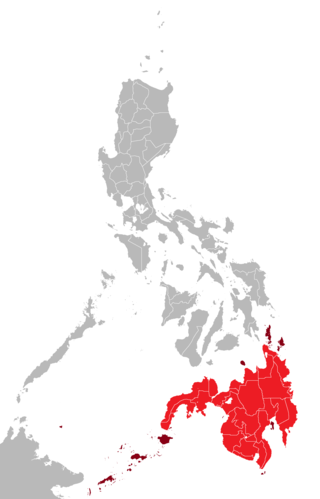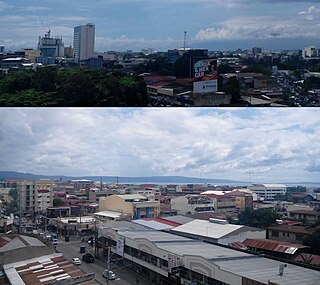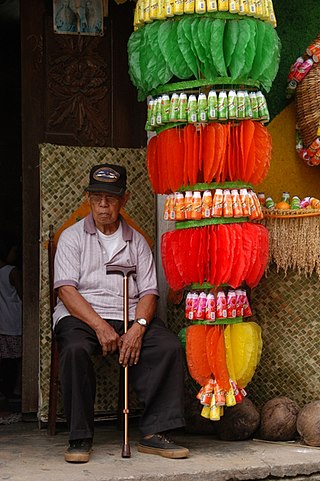
Mindanao is the second-largest island in the Philippines, after Luzon, and seventh-most populous island in the world. Located in the southern region of the archipelago, the island is part of an island group of the same name that also includes its adjacent islands, notably the Sulu Archipelago. According to the 2020 census, Mindanao has a population of 26,252,442 people, while the entire island group has an estimated population of 27,021,036 according to the 2021 census.

Zamboanga del Sur, officially the Province of Zamboanga del Sur, is a province in the Philippines located in the Zamboanga Peninsula region in Mindanao. Its capital is the city of Pagadian. Statistically grouped with Zamboanga del Sur is the highly urbanized City of Zamboanga, which is geographically separated and a chartered city and governed independently from the province.

Davao Region, formerly called Southern Mindanao, is an administrative region in the Philippines, designated as Region XI. It is situated at the southeastern portion of Mindanao and comprises five provinces: Davao de Oro, Davao del Norte, Davao del Sur, Davao Oriental and Davao Occidental.

Pagadian, officially the City of Pagadian, is a 2nd class component city and the capital of the province of Zamboanga del Sur, Philippines. It is the regional center of Zamboanga Peninsula and the second-largest city in the region and in the province, after the independent city of Zamboanga. According to the 2020 census, it has a population of 210,452 people. The city will be converted to a highly urbanized city by the virtue of Proclamation No. 1247, signed by President Rodrigo Duterte dated November 8, 2021, but shall take effect after the ratification in a plebiscite.

The Pan-Philippine Highway, also known as the Maharlika Highway, is a network of roads, expressways, bridges, and ferry services that connect the islands of Luzon, Samar, Leyte, and Mindanao in the Philippines, serving as the country's principal transport backbone. Measuring 3,379.73 kilometers (2,100.07 mi) long excluding sea routes, it is the longest highway in the Philippines that forms the country's north–south backbone component of National Route 1 (N1) of the Philippine highway network. The entire highway is designated as Asian Highway 26 (AH26) of the Asian Highway Network.

DXMJ-TV is a television station in Metro Davao, Philippines, serving as the Mindanao flagship of the GMA network. It is owned and operated by the network's namesake corporate parent alongside GTV outlet DXRA-TV. Both stations share studios and transmitters at the GMA Complex, Broadcast Ave., Shrine Hills, Brgy. Matina Crossing, Davao City.

The Christian And Missionary Alliance Churches of the Philippines (CAMACOP) is a Christian evangelical group in the Philippines that originated from The Christian and Missionary Alliance (C&MA). It is one of the largest evangelical groups in the Philippines.

The following outline is provided as an overview of and topical guide to the Philippines:

The Port of Davao, or Davao Port, is a seaport located in Davao, Philippines. The Port of Davao consists of a number of ports, all within Davao Gulf which is part of the Celebes Sea, but its main office and seaport is located at Brgy. Sasa, Davao City. The Port of Davao is largely dominated by container cargo, raw materials exportation, bulk cargo, general cargo, and passenger traffic facilities.

Metro Davao, officially called Metropolitan Davao, is a metropolitan area in the Mindanao island group, Philippines. It includes the cities of Davao City, Digos, Mati, Panabo, Samal and Tagum and spanned parts of all five provinces of Davao Region. Metro Davao is one of three metropolitan areas in the Philippines. It is administered by Metropolitan Davao Development Authority. It is the largest metropolitan region by land area and the second most populous in the Philippines.
Brigada Mass Media Corporation (BMMC) is a newspaper company and media network in the Philippines. It is the first-ever local Tri-media organization to have emerged from the Soccsksargen area as a national network with its array of Brigada News FM stations. BMMC is part of Brigada Group of Companies of entrepreneur Elmer Catulpos which also maintains three newspaper editions in Mindanao, one TV station, distribution of herbal food supplements, medicines, cosmetics and engine care products, a drug pharmacy, a garden resort and two private security agencies.
The 2012–13 PFF National Men's Club Championship was the 2nd season of the PFF National Men's Club Championship, a Filipino association football competition organized by the Philippine Football Federation.
The 2014–15 PFF National Men's Club Championship was the 4th season of the PFF National Men's Club Championship, a Filipino association football competition organized by the Philippine Football Federation.

ABS-CBN Regional Channel was a Philippine pay television channel which aired programming from the regional television and radio stations owned by ABS-CBN. The channel was launched as a test broadcast on August 1, 2016, and was officially launched on March 20, 2017.

Kiping is a traditional Filipino leaf-shaped wafer made from glutinous rice. It originates from the city of Lucban, Quezon. It is celebrated annually in the Pahiyas Festival. It can be eaten grilled or fried and can be dipped in sugar, vinegar, or other sauces.

Regional TV Weekend News is a Philippine television news broadcasting show broadcast by GMA News TV, GMA Network and GTV. It premiered on July 27, 2019, on GMA News TV and on March 21, 2020, on GMA Network. The show concluded on GMA Network on May 2, 2020. The show aired its last episode on July 24, 2021, to give way for Regional TV News.
COVID-19 community quarantines in the Philippines were series of stay-at-home orders and cordon sanitaire measures that have been implemented by the government of the Philippines through its Inter-Agency Task Force for the Management of Emerging Infectious Diseases (IATF-EID).
















